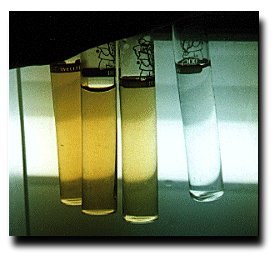
Ammonia: What water qualty parameter kills more aquarium and pond fish?
Ammonia: Most Common Killer of New Fish
– By Dr. Erik Johnson

Ammonia is the primary waste product of fish, excreted primarily through the gill tissue, but to a lesser extent via the kidney. Ammonia can also accumulate from the decay of fish tissues, food and other organic debris derived from protein. Ammonia accumulations cause reddening of the skin and disability of the gills by its direct caustic effect on these surfaces. Fish suffering in water with high ammonia accumulations will isolate themselves, lie on the bottom, clamp their fins, secrete excess slime, and are much more susceptible to parasitic and bacterial infection.
Ammonia is a big problem in new systems because the bacteria that would naturally dissolve ammonia are not established, see discussion of cycle. As well, even in established systems, ammonia may accumulate in springtime when the water is cold but fish are eating, because filter bacteria have not emerged usefully from hibernation.
Ammonia ionizes below pH 7.4 to Ammonium – and so in its ionized state is less toxic to fish.
Above pH 8.0 most ammonia is ionized, and so becomes more toxic. Care should be taken not to increase th pH of a system if ammonia is present but the need to drop the pH or restrict oxygenation to tanks of fish to keep pH down is a MISTAKE.
Treatment: Water changes and management of the pH near neutral will go a long way to cutting losses from Ammonia, ancillary, less useful modes of Ammonia management include the use of the various water conditioners that bind ammonia, and the application of rechargeable Zeolites to the system filter. I am still going to tell you that time and water changes are the two mainstays, however.
Water that is warm, high in pH or deprived of oxygen will have an enhanced toxicity when ammonia is accumulating. These are all important considerations as we try to interpret the varying symptoms of fish at the same ammonia level, for example, but are affected very differently.
More about ammonia
Ammonia – Understand this! – by Doc Johnson
Ammonia is the first waste product of your fish. It is often the cause of your first mortalities in new facilities and new ponds. There is a simple test to measure the levels. Bioseeding (look in the videos section of this site) may be the most effective method of all, when possible.
Highlights:
- Ammonia is made from rotting fish wastes/urine/food
- Tested with Nessler’s Drop Type tests
- After (the regrettable) addition of aldehydes such as Formalin or Ammonia-binder agents, test with Salicylate reagent tests.
- Ammonia causes redness of fins, general poor health, excess mucus production, flashing, and by chronic auto-intoxication: Pinecone disease.
- Ammonia is more toxic at pH above 8.0
- Ammonia is directly irritating to fish gills and tissues
- Ammonia is removed from the environment by beneficial bacteria called “Nitrosomonas”.
- You can control Ammonia with partial water changes or addition of Zeolites.
- I discourage the use of chemicals for Ammonia binding. All but a few of them contain aldehydes (glutaraldehyde) which are guilty of binding oxygen and irritating the fish.
Wet dry filtration (versus submerged media) is very superior for supporting nitrifying bacteria.
Additional notes:
“First of all, because it is foiled by fewer organic molecules, let’s establish that Salicylate test kits are superior to Nessler’s tests. Still, Ammonia testing can present a problem. You may not know that dechlorinator can zero-out your ammonia test. The reason is that in the salicylate test kit, chloride ions provide a reagent. Ample dehlorinator and other ammonia binders will zero out this free chlorine reagent and show you a zero test. The only way to be sure that the Ammonia is truly bound up is by “live-tissue cell culture histopathology”. Cells are bathed in test-water and then examined for tell-tale signs of Ammonia damage. The only company that has done this so far is Aquarium Pharmaceuticals who used Drs Lukert and Gratzek at UGA. This Ammonia binder does not contain any aldehydes. Even the so-called “Sulfide Ion” binders are often nothing but Formaldehyde-bi-sulfite (rongalite) which is incredibly unstable.” Doc Johnson
